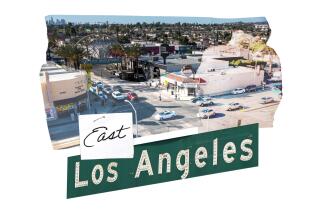East L.A. ready, financially, for independence
East Los Angeles could support itself as an independent city, according to a new report, boosting the latest effort to convert the unincorporated Mexican American cultural mecca into its own municipality.
Since 1961, supporters have tried three times to bring cityhood to the storied Latino community, and now the fourth movement seems to be gathering steam. This time, advocates say, the numbers prove a city of “East Los” could thrive.
The fiscal analysis, by an independent economic consultant, provides the most revealing financial picture to date of the area, according to cityhood organizers, who paid $25,000 for the report. A city of East Los Angeles could generate at least $48 million in projected annual revenue to support its own city council and such services as street upkeep, the study said.
Financial viability is crucial to a successful cityhood drive, which would transfer much of the decision-making authority from the Los Angeles County Board of Supervisors to a locally elected council.
Supervisor Gloria Molina, whose district includes East Los Angeles, remains neutral on the cityhood question and skeptical about the finances, despite the report.
“It’s very, very glamorous to think about a city incorporating itself,” said Molina, who wants further study and clarification. “Can it sustain itself? That’s the real question.”
Covering less than eight square miles, the city of East Los Angeles would be home to an estimated 135,000 residents, making it the 10th-largest city in the county. It still would pay the county to provide law enforcement, fire protection, traffic enforcement and animal control services, according to the report by Burr Consulting.
Because of reduced overhead costs, the city of East Los Angeles would pay only $13 million for law enforcement, compared with the $24 million the county spends for Sheriff’s Department protection there now, the study found. The Sheriff’s Department, however, questions that finding: “People usually contract with us because their overhead costs are reduced dramatically without reducing the quality of law enforcement,” said sheriff’s spokesman Steve Whitmore.
Residents of the city of East Los Angeles might pay more for trash pickup.
What would change most dramatically, according to backers of the effort, would be East L.A.’s ability to shape its destiny.
The area, crisscrossed by four freeways, “has been an orphaned child in Los Angeles County,” said state Sen. Gloria Romero (D-Los Angeles), a strong supporter of cityhood for the area. “This is a vibrant community with a long history that cries out for representation.”
Previous tries for cityhood faltered because of business and homeowner opposition, a lack of financial support and fear of higher property taxes.
East Los Angeles residents, nearly all Latino, are poorer than those of nearby cities; the area long has grappled with gang violence. But Molina has worked to put more sheriff’s deputies on the street and opened a government services center in February. She heralded the recent arrival of a Starbucks as a sign of economic revitalization. And the Gold Line light-rail extension, now being built, will connect East L.A. with downtown.
On the streets of East L.A. one recent day, views on prospective cityhood were mixed.
Working at Botanica la Merced on Cesar Chavez Avenue, Carlos Martinez, 53, said crime had decreased in recent years, and life was pretty good. But he’d like to see local activists attract businesses and jobs.
The report found that sales tax revenue wasn’t as high as organizers had hoped, and they complain that too much East Los Angeles land has been used as a “dumping ground” for such tax-exempt county facilities as sheriff’s and fire services.
Some people were opposed to cityhood.
“I think you should just belong to the county,” said Basilio Landeros, 44, co-owner of Party Planet Supplies. “The county has all the funds.
“If [the San Fernando Valley] couldn’t become a city, why do you think East Los Angeles could become a city?” Landeros asked. The Valley “has more clout. . . . To me, it’s better to leave it the way it is.”
But others saw the possibilities.
For Garfield High School senior Jackie Amaya, it’s just a matter of educating residents. “They’re not fully aware of what the benefits could be,” said Jackie, 17, who learned about the issue from her government teacher Alberto Palacios, a cityhood activist.
The financial report is only the first step in a lengthy process. Organizers must gather signatures from 25% of East L.A.’s 34,000 registered voters to proceed with incorporation. Then, the county agency that oversees the formation of cities must prepare its own economic report, which could take six months or more, and ultimately hold a hearing to approve the incorporation effort. The Board of Supervisors also would review that decision. Finally, East L.A. voters would decide whether to make East L.A. a city.
Organizers hope to incorporate by April 2009.
There is incentive to move quickly: Under state law, cities formed after June 2009 stand to lose a chunk of the vehicle license fees and gasoline tax revenue that would help them cover the cost of providing services.
“We’re not going away,” said Oscar Gonzales Jr., president of the East Los Angeles Residents Assn., which funded the study. “We want to try and make things better.”
--
susannah.rosenblatt@latimes.com
--
(BEGIN TEXT OF INFOBOX)
East Los Angeles at a glance
Area: 7.47 square miles
Population: 135,000 (est.)
Residents: 97% Latino, about one-third undocumented
Median household income*: $28,544 ($42,189 countywide)
Families below poverty level*: 27% (14% countywide)
Percentage of residents owning home*: 36% (48% countywide)
Employment: 22,457 jobs
Jobs by industry:
33% public administration
15% education
13% healthcare and social assistance
11% manufacturing
6% leisure and hospitality
5% retail
--
Remainder miscellaneous service jobs
--
* 2000 data
--
Source: Independent fiscal analysis by Burr Consulting
More to Read
Sign up for Essential California
The most important California stories and recommendations in your inbox every morning.
You may occasionally receive promotional content from the Los Angeles Times.









